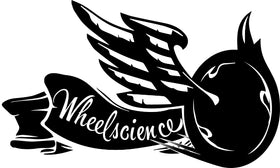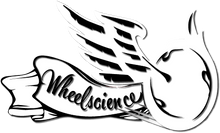Why do wider tires need less PSI?
Cycling is constantly changing and although bikes have been around since the 1800s we are seeing bikes evolve and become more aerodynamic, lighter, faster and even better looking. Wheels are getting wider and materials are becoming stronger than ever before to the point that we rarely even ever need to adjust spokes.
In recent years one of the biggest changes has come in our tires. A decade ago road cyclist were riding 23c tires and there was a big belief that skinnier was quicker. Years went by and we saw the professionals go to 25c then many now are riding 28c and even 30c on some races.
With an increase in tire size we started to see much lower pressures. Many people have come to ask the question why do wider tires need less PSI. In this article we're going to speak about why, the advantages and disadvantages of lower pressures, and explain how you can get the perfect pressure for the tires your bike.
What is tire pressure?
The first thing we need to explain is what is tire pressure in it most essential basic form. Tire pressure is measured in PSI, which is an imperial measurement. PSI stands for Pounds per square inch. It is the force a gas (pneumatic pressure) or liquid (hydraulic pressure) exerts on an area. So for us as cyclists the more PSI in the inside of a tire or inner tube the more solid the tire or tube becomes.

Why do larger tires need less pressure?
Larger tires are designed for many uses on bicycles. They are used to improve the shape of the contact patch on the floor, to provide more volume so they tire has more flexibility, and also a larger tire can protect the rim from being damaged on off road bikes.
But the actual reason lower pressures are needed is something called HOOP STRESS. Great name right! In basic terms hoop stress means for any given pressure in a cylinder ( for cycling think "tire") the wider the diameter, the higher the overall force that is applied to the cylinder walls. Without getting too mathys, lets say tire A has double the internal diameter of tire B. They are both at 100 psi. As an example we are going to say that if you took a one inch length of tire A its total internal area is 2 square inches. The tire casing has 200lbs being applied to it (100psi x 2 square inches), while tire B only have 100 psi being applied to it, being 1/2 the area (100psi x 1 square inch). This means tire A would feel much, much harder than tire B. Tire A would also being applying around twice the force to the wheel rim it is attached to, trying to pull it apart.
Larger tires, to work effectively need to have lower pressures inside so as to maintain the ratio of tire width to contact patch, critical for the tires to work as designed. If you we're to run a larger tire width say 35c at the same tire pressure as a 23c road bike (100 PSI) then you lower the contact patch, increase the rebound from the bumps, and they might explode if you over inflate them past the manufacturers recommendations. We hope that makes sense, we've kept the above to the basic principles, not the detailed physics - feel free to google hoop stress if you want to get into detailed science.

What are some of the advantages of lower tire pressures?
Lower pressure tires come with a many benefits you might or might not know about and can certainly improve your riding experience.
Extra Comfort
The first thing to mention is the amount of extra comfort you get from running lower tire pressure. With less air pressure in the tires it makes them much more forgiving compared to heavily inflated tires. For long distance cycling it's ideal and can really take the edge off those nasty lumpy roads.
Larger Contact Patch
The next benefit is having a larger contact patch. This means when you are riding you get more of the tires surface on the floor. This can provide you with extra grip on corners and greatly improve handling capabilities. Many professional riders will drop the tire pressure on certain courses if they feel the need for extra grip.
Reduced Resistance to Progress
This is also classed as roll over ability. It means when you are riding and the tire hits a small object instead of the air pressure bouncing off the object because the pressure is high it has the ability to roll over it instead. This can actually have a very positive effect on speed and on certain routes very noticeable. But also note our rolling resistance notes below, it's a balance.

The Disadvantages
If we speak about advantages to lower pressures it's vital to also speak about disadvantages, they are worth knowing if you’re planning on winning races.
More Rolling Resistance
With less tire pressure and in turn a larger contact patch you can expect to gain rolling resistance. The more rolling resistance the more energy it's going to take to drive the bike forward. Surprisingly the amount of watts extra is minimal, a good example is this:
- Schwalbe Pro One Tubeless
- Information Provided by (ReneHerse Cycles)
- 120 PSI - 11 watts rolling resistance
- 100 PSI - 11.6 watts rolling resistance
- 80 PSI - 12.8 watts rolling resistance
- 60 PSI - 14.8 watts rolling resistance
You do end up with more rolling resistance but it is minimal compared to what you might think. The difference between 120 PSI and 60 PSI is 3.8 watts, which is very little and roughly 2% for the average rider. Although lower rolling resistance can improve your speed it isn't going to do your level of comfort any favours, but we understand for a professional Tour de France rider this is a huge amount and could be a race winning difference.
Aerodynamics
Contrary to what some brands are saying at the moment wider tires are in simple terms not faster than thinner tires. If they were all the track riders would be on them, and they are not. Wider tires and rims help give stability to wheels is windy conditions and can reduce overall drag at certain yaw angles BUT on a calm day in a straight line they are not necessarily faster.

How to get the right tire pressure for your bike?
Now your probably curious to find out the perfect tire pressure for you tires and your riding. This can be very challenging to find out and many factors come into getting the correct tire pressure for you such as tire size, rim width, riders weight, temperature, the type of riding your doing, and even altitude. Here are our top methods on getting correct tire pressure.
Rough Calculations
If your switching to larger tires and are looking just for a rough calculation then this is an good way to get you roughly at the right pressure. Say you run 100 psi on a 23c tire and are upgrading to a 28c tire then typically we will drop the pressure by the volume you increase. So say 23c is 100% volume it would go like this:
- 23c - 100% Volume - 100 PSI
- 25c - 115% Volume - 85 PSI
- 28c - 133% Volume - 65-70 PSI
It's a very simple method and will only give you a rough idea but it's an excellent place to start on finding the right tire pressure for you.
Use an online Tire Pressure Calculator
There are also many online calculators you can use, which will take much more into account, such as the type of riding you are doing and your height and weight. One of our favorites is the Silca Professional.

Conclusion
To get the benefits of a bigger tire, they must be run at lower pressures. Larger tires are becoming increasingly popular in the cycling industry, and we are learning that you don't need small skinny tires with high PSI ratings to be fast. Bigger tires can offer better grip and more comfort and are excellent at protecting your rims. But as with everything it's about understanding the right set up for any given ride.
Wheel selection
It is vital that you have the right wheels for your riding style. With so much hype out in the market it can hard to know which wheels are right for you. At Wheelscience we are riders too, so we want to make sure you have the right tools for the job. You can be a crit racer, a climber, a cruiser, a triathlete, a downhill specialist or an all-mountain adventurer. Whatever you are, we can help you pick the right tools for the job. We have compiled a questionnaire to help you make the right choices with your wheels. Interested? Fill out the below form.
We will also send you a special DISCOUNT code with your wheel match!
Don't like forms? Why not book a consultation with Peter in person! Use the below link to book a call, no charge of course. We always loves to talk wheels.
BOOK A CALL
If you are after track wheels - please click here.
If you would rather just email than please do. Peter@wheelscience.com
You can also see what some of our riders have been up to on our RIDERS page HERE




Leave a comment